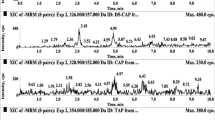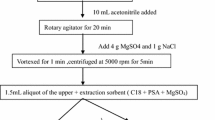Abstract
An analytical method for determination and confirmation of nine coccidiostatics in eggs is reported. Ethyl acetate is used as extraction solvent, with satisfactory results, and simple automated clean-up is based on gel-permeation chromatography (GPC) . The target compounds are then analysed by liquid chromatography–electrospray ionization–tandem mass spectrometry. The method was validated in-house in accordance with Commission Decision 2002/657/EC. Trueness and precision were determined at four concentrations, and the mean errors obtained were <10 %, with relative standard deviations ranging from 3 to 18 %. For three non-authorized coccidiostatics (clopidol, ethopabate, and ronizadole), decision limit and detection capability were in the ranges 0.12–0.16 and 0.18–0.23 μg kg−1, respectively. The results obtained prove the suitability of this new analytical method for routine monitoring of these substances in eggs.



Similar content being viewed by others
References
Report from the Commission to the Council and the European Parliament on the use of coccidiostats and histomonostats as feed additives submitted pursuant to article 11 of regulation (ec) no 1831/2003 of the European Parliament and of the Council of 22 september 2003 on additives for use in animal nutrition, Brussels 5.5.2008
European Union, Regulation (EC) No 1831/2003 of the European Parliament and the Council of 22 September 2003 on additives for use in animal nutrition. Off J Eur Commun L268:29–43
Commision Recommendation 2005/925/EC of 14 December 2005 on the coordinated inspection programme in the field of animal nutrition for the year 2006 in accordance with Council Directive 95/53/EC
Commision Regulation (EC) No 124/2009 of 10 February 2009. Off J Eur Commun L40:7–11
Delahaut P, Pierret G, Ralet N, Dubois M, Gillard N (2010) Multi-residue method for detecting coccidiostats at carry-over level in feed by HPLC-MS/MS. Food Addit Contam 27(6):801–809
Cronly M, Behan P, Foley B, Malone E, Shearan P, Regan L (2011) Determination of eleven coccidiostats in animal feed by liquid chromatography-tandem mass spectrometry at cross contamination levels. Anal Chim Acta 700:26–33
Vicent U, Ezerskis Z, Chedin M, Von Holst C (2011) Determination of ionophore coccidiostats in feeding stuffs by liquid chromatography-tandem mass spectrometry. Part II. Application to cross-contamination levels and non-targeted feed. J Pharm Biomed Anal 54:526–534
Mortier L, Huet A-C, Charlier C, Daesaleire E, Delahaut P, Van Peteghem C (2005) Incidence of residues of nine anticoccidials in eggs. Food Addit Contam 22(11):1120–1125
Rokka M, Peltonen K (2006) Simultaneous determination of four coccidiostats in eggs and broiler meat: validation of an LC-MS/MS method. Food Addit Contam 23(5):470–478
Mortier L, Daeseleire E, Van Peteghem C (2005) Determination of the ionophoric coccidiostats naransin, monensin, lasalocid and salinomycin in eggs by liquid chromatography/mass spectrometry. Rapid Commun Mass Spectrom 19:533–539
Mortier L, Daeseleire E, Delahaut P (2003) Simultaneous detection of five coccidiostats in eggs by liquid chromatography-tandem mass spectrometry. Anal Chim Acta 483:27–37
Matabadul DK, Conway B, Lumley I, Sumar S (2001) The simultaneous determination of the ionophore antibiotics in animal tissues and eggs by tandem electrospray LC-MS-MS. Food Chem 75:345–354
Rosén J (2001) Efficient and sensitive screening and confirmation of residues of selected polyether ionophore antibiotics in liver and eggs by liquid chromatography-electrospray tandem mass spectrometry. Analyst 126:1990–1995
Shao B, Wu X, Zhang J, Duan H, Chu X, Wu Y (2009) Development of a rapid LC-MS-MS method for multi-class determination of 14 coccidiostat residues in eggs and chicken. Chromatographia 69:1083–1088
Dubois M, Pierret G, Delahaut P (2004) Efficient and sensitive detection of residues of nine coccidiostats in egg and muscle by liquid chromatography- electrospray tandem mass spectrometry. J Chromatogr B 813:181–189
Dubreil-Chéneau E, Bessiral M, Roudaut B, Verdon E, Sanders P (2009) Validation of a multi-residue liquid chromatography-tandem mass spectrometry confirmatory method for 10 anticoccidials in eggs according to Commission Decision 2002/657/EC. J Chromatogr A 1216:8149–8157
Galarini R, Fioroni L, Moretti S, Pettinacci L, Dusi G (2011) Development and validation of a multi-residue liquid chromatography-tandem mass spectrometry confirmatory method for eleven coccidiostats in eggs. Anal Chim Acta 700:167–176
Matabadul DK, Lumley ID, Points JS (2002) The determination of 5 anticoccidial drugs (nicarbazin, lasalocid, monensin, salinomycin and naransin) in animal livers and eggs by liquid chromatography linked with tandem mass spectrometry (LC-MS-MS). Analyst 127:760–768
(1994) Method 3640. US Environmental Protection Agency
Wu G, Bao X, Zhao S, Wu J, Han A, Ye Q (2011) Analysis of multi-pesticide residues in the foods of animal origin by GC-MS coupled with accelerated solvent extraction and gel permeation chromatography cleanup. Food Chem 126:646–654
Guardia-Rubio M, Marchal-López RM, Ayora Cañada MJ, Ruiz- Medina A (2007) Determination of pesticides in olives by gas chromatography using different detection systems. J Chromatogr A 1145:195–203
Wang JH, Guo C (2010) Ultrasonication extraction and gel permeation chromatography clean-up for the determination of polycyclic aromatic hydrocarbons in edible oil by an isotope dilution gas chromatography–mass spectrometry. J Chromatogr A1217:4732–4737
Liu YP, Li JG, Zhao YF, Wu YN, Zhu LY (2009) Rapid determination of polybrominated diphenyl ethers (PBDEs) in fish using selective pressurized liquid extraction (SPLE) combined with automated online gel permeation chromatography-gas chromatography mass spectrometry (GPC-GC/MS). Food Addit Contam 26(8):1180–1184
Cavaliere B, Macchione B, Sindona G, Tagarelli A (2008) Tandem mass spectrometry in food safety assessment: the determination of phtalates in olive oil. J Chromatogr A 1205:137–143
Niu Y, Zhang J, Wu Y, Shao B (2011) Simultaneous determination of bisphenol A and alkylphenol in plant oil by gel permeation chromatography and isotopic dilution liquid chromatography-tandem mass spectrometry. J Chromatogr A 1218:5248–5253
Kaklamanos G, Theodoridis G, Dabalis T (2009) Gel permeation chromatography clean-up for the determination of gestagens in kidney fat by liquid chromatography-tandem mass spectrometry and validation according to 2002/657/EC. J Chromatogr A 1216:8067–8071
Pardo O, Yusà V, León N, Pastor A (2009) Development of a method for the analysis of seven banned azo-dyes in chilli and hot chilli food samples by pressurized liquid extraction and liquid chromatography with electrospray ionization-tandem mass spectrometry. Talanta 78:178–186
Pang G-F, Cao Y-Z, Zhang J-J, Fan C-L, Liu Y-M, Li X-M, Jia J-Q, Li Z-Y, Shi Y-Q, Wu Y-P, Guo T-T (2006) Validation study on 660 pesticide residues in animal tissues by gel permeation chromatography cleanup/gas chromatography–mass spectrometry and liquid chromatography-tandem mass spectrometry. J Chromatogr A 1125:1–30
Abuín S, Compañó R, Centrich F, Rúbies A, Prat MD (2008) Analysis of thyreostatic drugs in thyroid samples by liquid chromatography tandem mass spectrometry: comparison of two sample treatment strategies. J Chromatogr A 1207:17–23
Watson DH (2004) Pesticide, veterinary and other residues in food. Woodhead Publishing Limited, Cambridge, ISBN 1 85573 910 0
Commision Regulation (EC) No 37/2010 of 22 December 2009. Off J Eur Commun L15:1–72
Commission Decision 2002/657/EC of 12 August 2002. Off J Eur Commun L221:8–36
Miao XS, March RE, Metcalfe CD (2003) Fragmentation study of salinomycin and monensin A antibiotics using electrospray quadrupole time-of-flight mass spectrometry. Rapid Commun Mass Spectrom 17:149–154
Lopes NP, Stark CBW, Hong HP, Gates J, Stauton J (2002) Fragmentation studies on momensin A and B by accurate-mass electrospray tandem mass spectrometry. Rapid Commun Mass Spectrom 16:414–420
ISO 11843–4:2003 (2003) ISO, Genève
Acknowledgments
Financial support from the Spanish Ministerio de Ciencia y Tecnología (CiCYT Project AGL2008-05578-C05-03) is gratefully acknowledged.
Author information
Authors and Affiliations
Corresponding author
Rights and permissions
About this article
Cite this article
Chico, J., Rúbies, A., Centrich, F. et al. Use of gel permeation chromatography for clean-up in the analysis of coccidiostats in eggs by liquid chromatography–tandem mass spectrometry. Anal Bioanal Chem 405, 4777–4786 (2013). https://doi.org/10.1007/s00216-013-6896-z
Received:
Revised:
Accepted:
Published:
Issue Date:
DOI: https://doi.org/10.1007/s00216-013-6896-z




